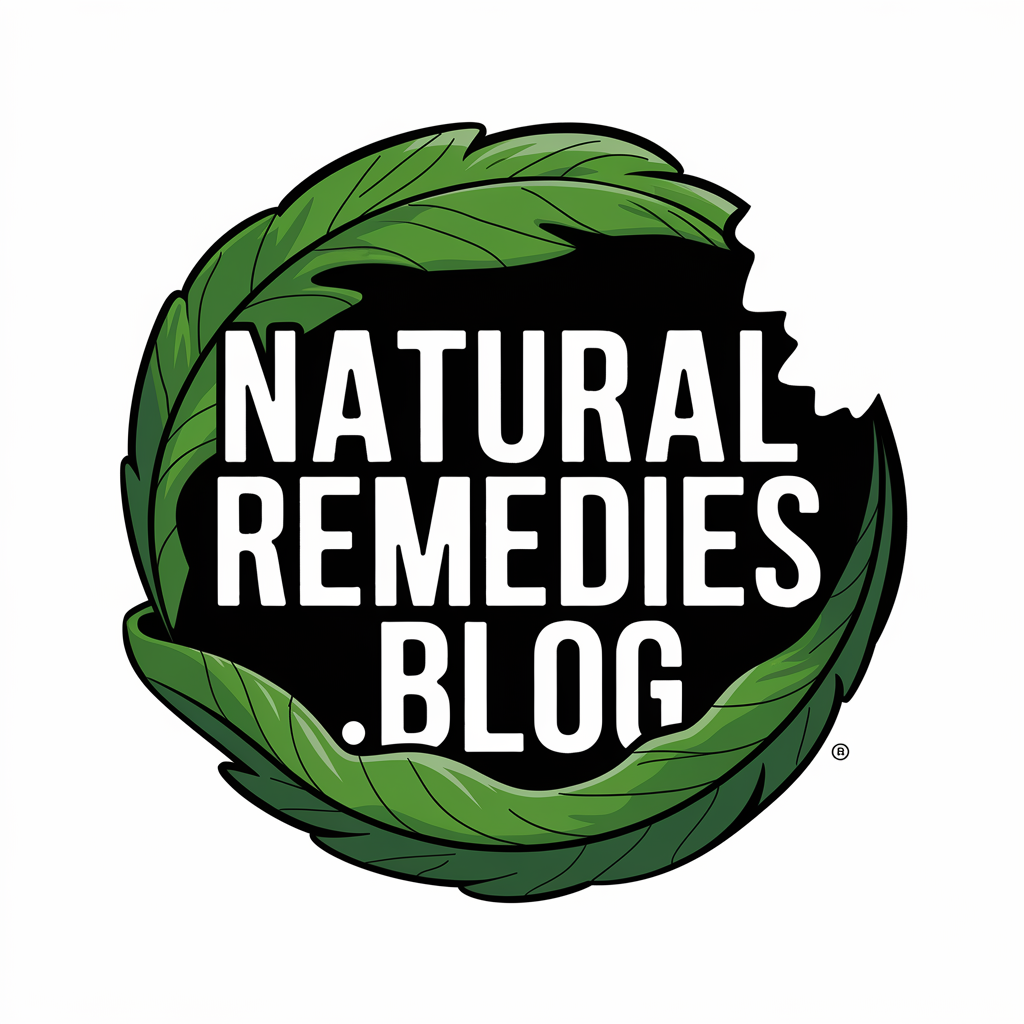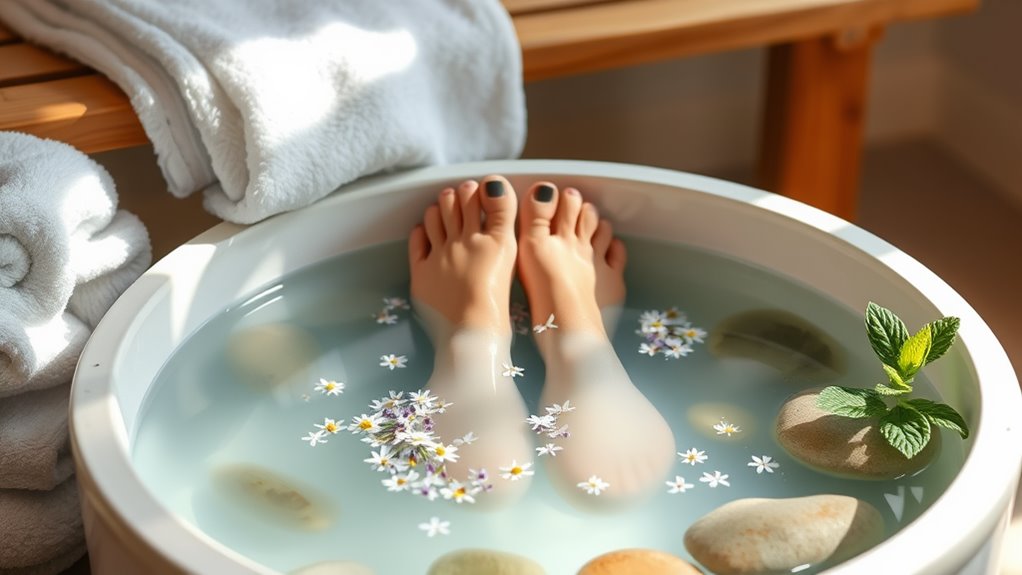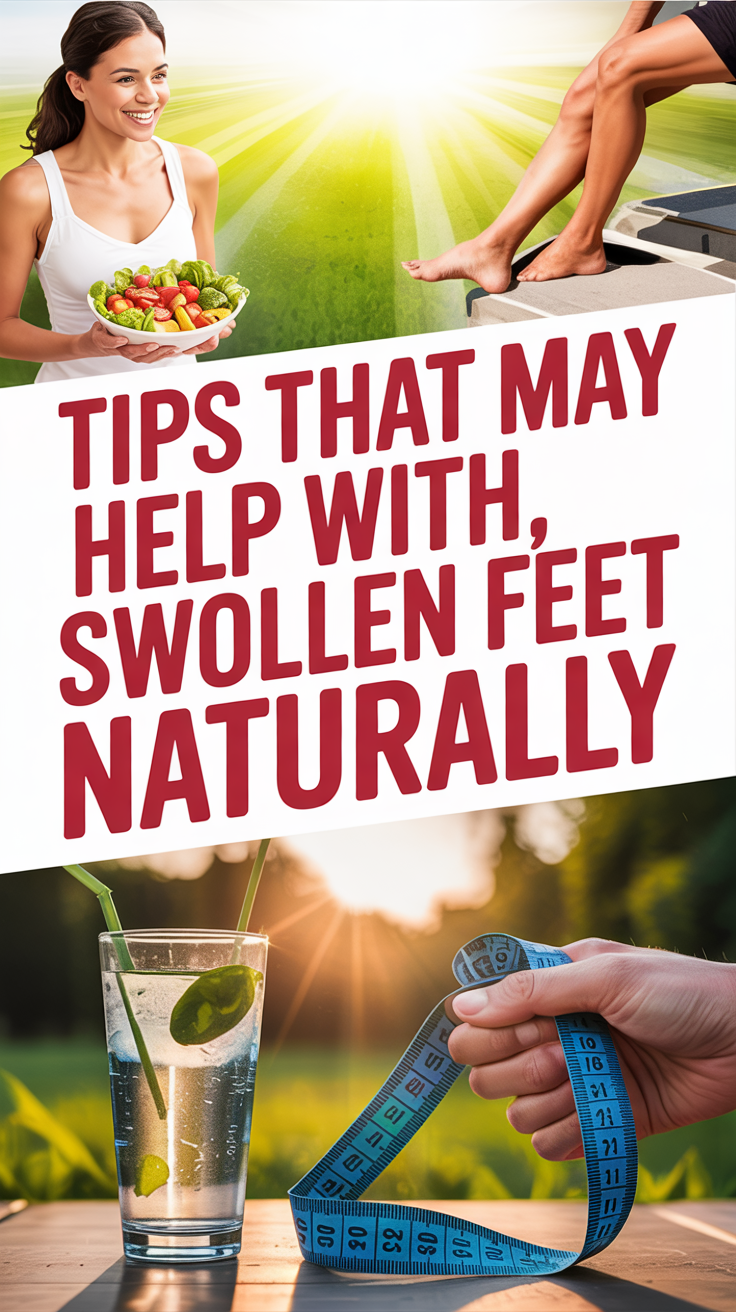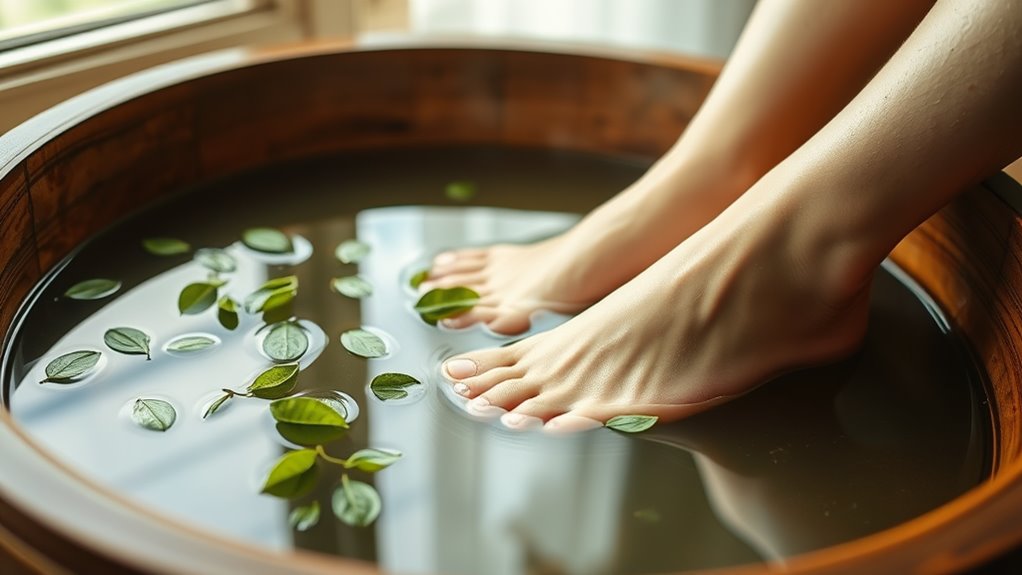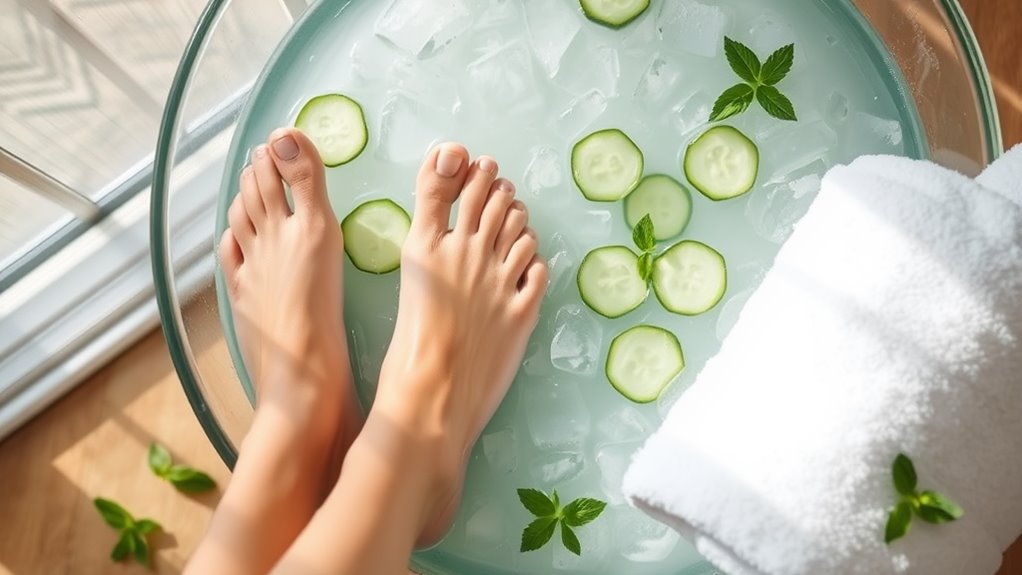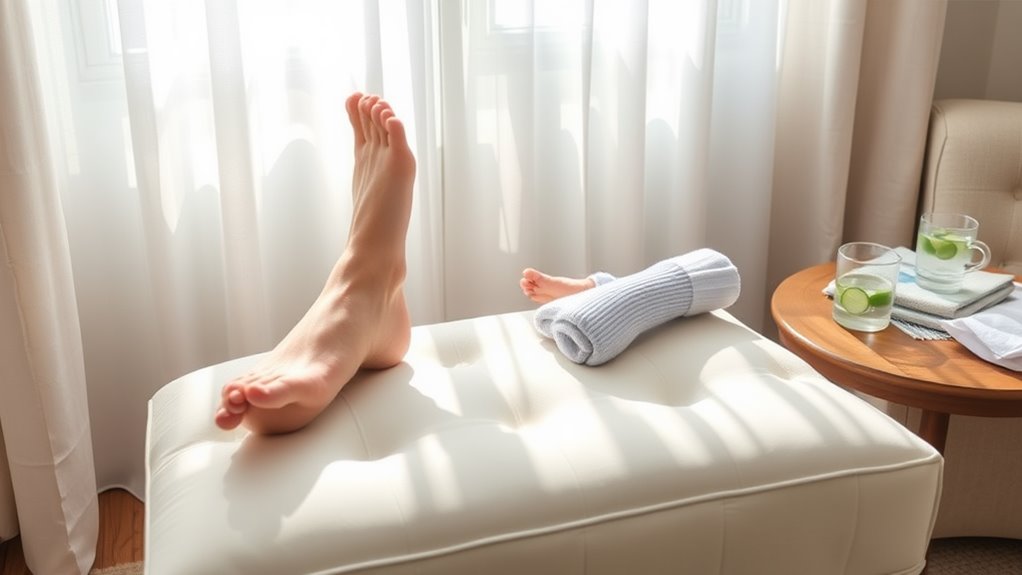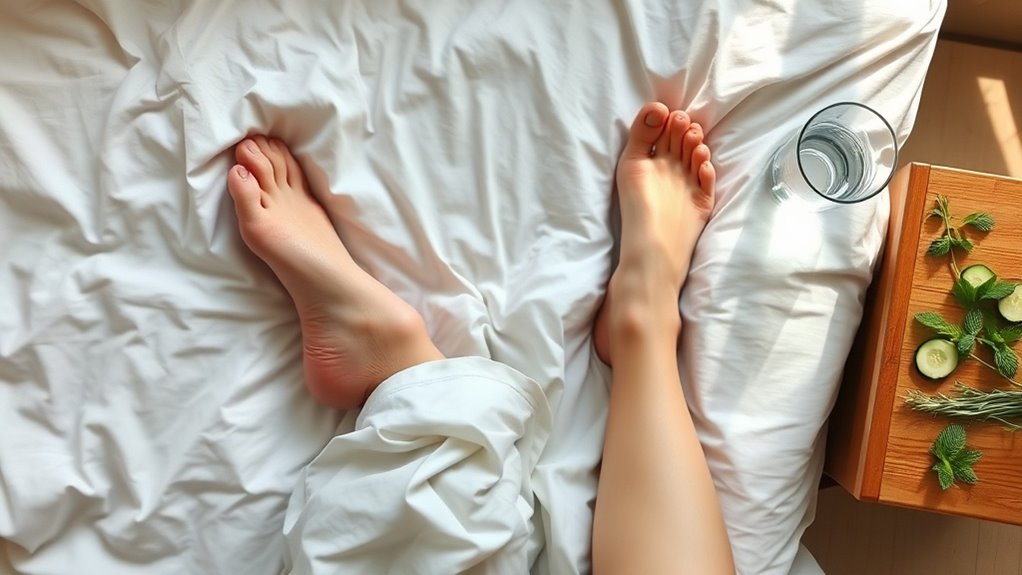Tips That May Help With Tired, Swollen Feet Naturally
To manage tired, swollen feet naturally, stay hydrated and limit sodium intake. Elevate your feet above heart level for 15 minutes, several times daily, and wear compression stockings to reduce swelling. Soak your feet in warm water with Epsom salts for relaxation and improved circulation. Choose comfortable, wide footwear that accommodates swelling, and incorporate potassium and magnesium-rich foods into your diet. Explore additional techniques and insights to further enhance your foot health and reduce discomfort.
Hydration and Dietary Adjustments
To effectively manage tired, swollen feet, focusing on hydration and dietary adjustments is essential.
Start by drinking plenty of water to maintain fluid balance, preventing unnecessary retention. Dehydration leads to constriction of blood vessels, which can result in fluid forced into spaces between cells and subsequently contribute to swelling. It’s important to recognize that normal bodily changes during pregnancy may also contribute to fluid retention and should be monitored closely.
Limit high-sodium foods, as they can cause swelling, while increasing potassium-rich items like bananas to help balance electrolyte levels.
Incorporate magnesium-rich foods to reduce inflammation effectively.
Also, reduce alcohol and caffeine consumption, which can dehydrate you.
Consider herbal teas like ginger or peppermint to aid circulation and inflammation.
These dietary adjustments serve as natural swollen feet remedies, helping alleviate discomfort and promoting overall foot health.
Stay consistent for optimal results.
Foot Elevation and Compression
Foot elevation and compression are effective techniques for managing tired, swollen feet, providing immediate relief and long-term benefits.
Elevating your legs above your heart for at least 15 minutes several times a day encourages fluid drainage and enhances blood circulation. This practice also improves blood flow by countering gravity, which aids the return of oxygen-depleted blood to the heart. Additionally, regular foot elevation helps reduce fluid retention in the lower extremities.
Using cushions can help position your legs optimally.
Compression stockings apply strategic pressure, improving circulation and reducing swelling by pushing blood upward, preventing pooling.
For maximum benefit, consider combining these methods—elevating your legs while wearing compression socks.
Always consult a healthcare provider before starting any new regimen, especially if you have underlying health conditions.
Regular practice can significantly improve your leg health.
Soaking and Massage Therapies
Soaking your feet in warm water for 15-20 minutes relaxes muscles and enhances circulation. Adding Epsom salts or essential oils like lavender can further reduce inflammation and swelling. Epsom salt has properties that draw excess fluid from tissues through osmosis, making it an effective choice for soothing swollen feet. Alternating hot and cold water also stimulates blood flow, which is particularly beneficial for swelling due to prolonged standing.
For massage, gentle movements, especially around the ankles, can effectively alleviate swelling. Techniques like ankle circles and toe massages promote relaxation and improve circulation. Regular practice of these therapies can significantly reduce tiredness and discomfort, making foot self-care an essential part of your wellness routine.
Footwear and Lifestyle Modifications
After exploring the benefits of soaking and massage therapies for tired, swollen feet, it’s important to recognize that footwear and lifestyle choices play a significant role in managing this discomfort.
Opt for wide, adjustable shoes made of soft, breathable materials to accommodate swelling, as design elements for swollen feet shoes prioritize comfort and fit. Proper footwear can help mitigate the effects of poor circulation, which often contributes to swelling.
Ensure they’ve deep toe boxes and flexible uppers for comfort.
Stay hydrated, manage your weight, and limit prolonged standing to reduce swelling.
Elevate your feet periodically and avoid tight clothing.
Incorporate regular exercise and take breaks during long periods of sitting or standing.
These adjustments can significantly alleviate discomfort and promote better foot health.
Supplements and Mineral Intake
Wondering how supplements and proper mineral intake can help alleviate tired, swollen feet? Incorporating vitamins and minerals can significantly impact your condition.
Vitamin B, particularly B-1, B-6, and B-12, can combat edema. Vitamin deficiencies are linked to foot pain, making these B vitamins important for relief. Additionally, maintaining a healthy weight can enhance the effectiveness of these vitamins in reducing swelling.
Magnesium assists in reducing water retention, while potassium balances fluid levels, minimizing swelling. Omega-3 fatty acids, found in fish, help reduce inflammation and improve circulation.
Consider including magnesium-rich foods like nuts and seeds, potassium-rich options like bananas and lentils, and omega-3 sources like salmon. These nutrients work synergistically to reduce swelling and enhance overall foot health, making a notable difference in your daily comfort.
General Considerations and When to Seek Medical Care
When dealing with swollen feet, it’s essential to differentiate between painful and painless swelling, as this can indicate varying underlying issues. If you experience persistent swelling, especially when accompanied by severe symptoms, it’s important to consult a doctor. Early intervention can be crucial in addressing potential complications and ensuring proper care. Additionally, understanding the common triggers of foot swelling can aid in better management and prevention strategies.
Pain vs. Painless Swelling
How can you tell the difference between painful and painless swelling in your feet?
Painful swelling often indicates conditions like injuries or infections, leading to redness, warmth, or tenderness.
Common causes include ankle sprains, cellulitis, and blood clots.
In contrast, painless swelling might stem from venous insufficiency, pregnancy, or prolonged sitting.
It’s often benign but can also signal heart failure or aging-related fluid retention.
While home remedies can alleviate mild swelling, understanding the underlying causes is crucial.
If you experience persistent painful swelling, it’s important to seek medical evaluation for a proper diagnosis and treatment plan.
When to Consult Doctor
Recognizing the right moment to consult a doctor about foot swelling is crucial for your health.
If you experience severe swelling, sudden increases, or swelling that lasts several days despite home remedies, seek medical care.
Symptoms like chest pain, shortness of breath, or fever accompanying the swelling require immediate attention.
Pay close attention to swelling leaving an indentation, pain, discoloration, or one-sided swelling, as these may indicate serious conditions such as blood clots or infections.
Furthermore, if you have a history of heart, kidney, or liver diseases, report any new swelling to a healthcare professional promptly for proper evaluation.
